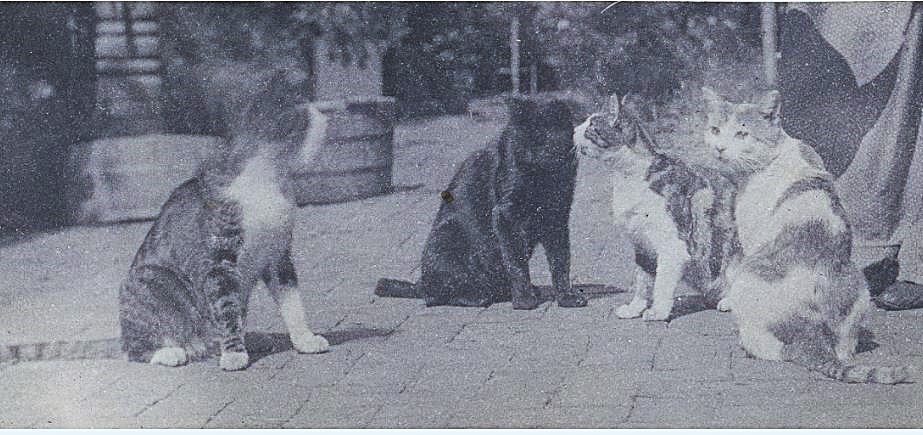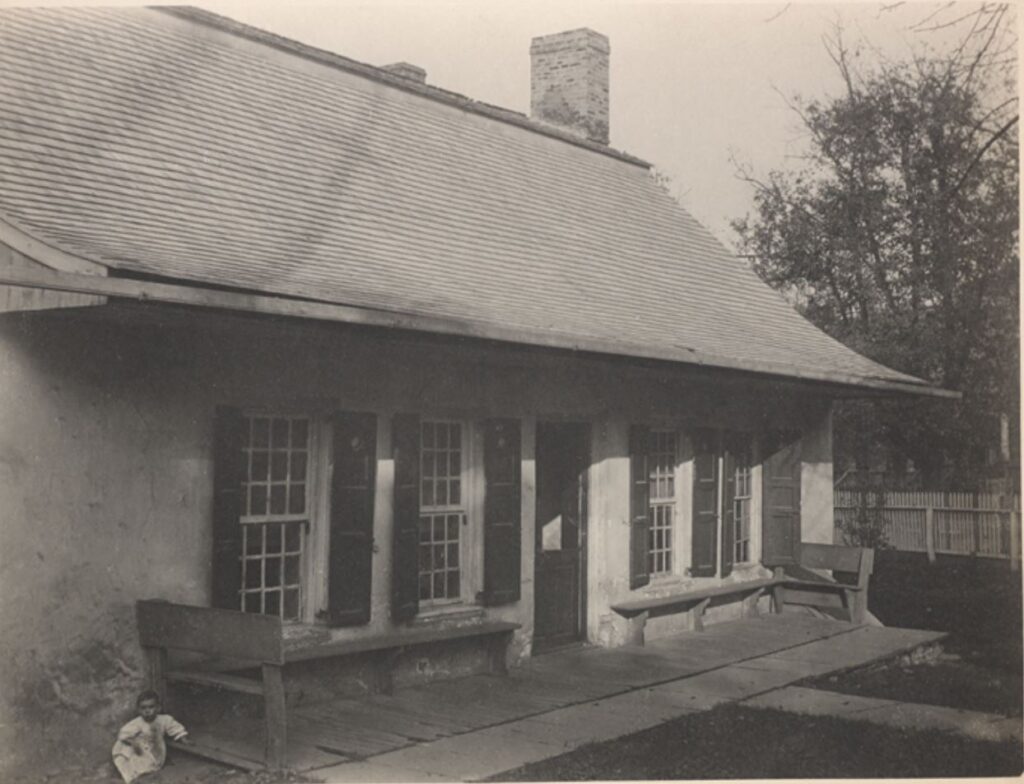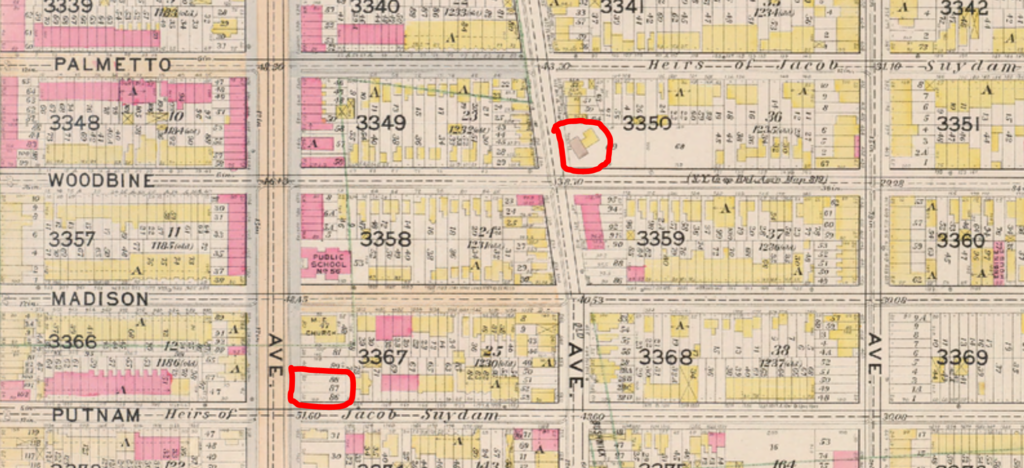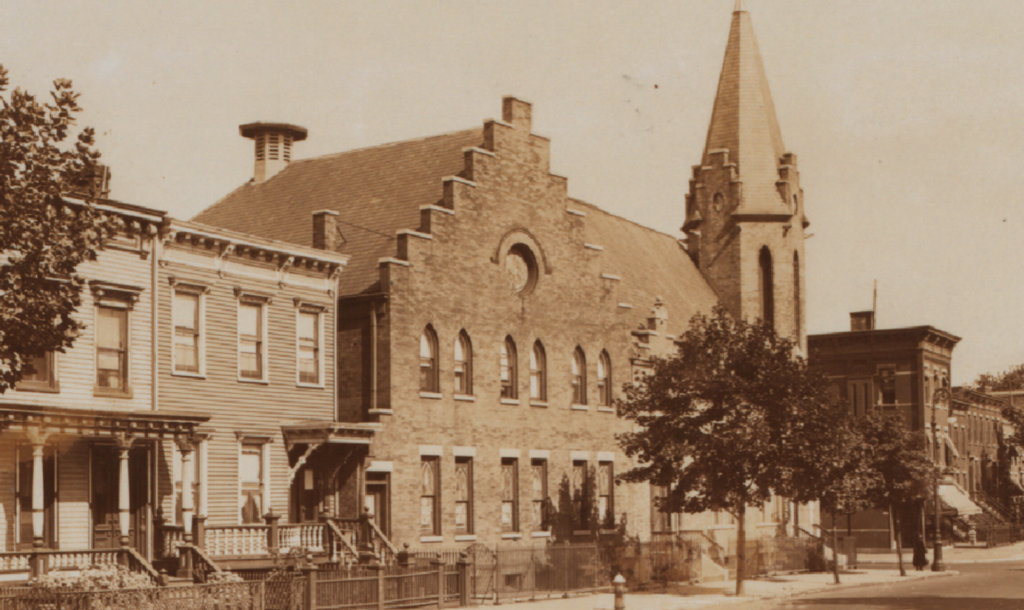
Every so often, I find an animal story of Old New York that is so silly or absurd, I start laughing out loud. I hope this following tale of a neighbor dispute on Putnam Avenue in Bushwick, Brooklyn will also leave you laughing. (And if you want something more serious, I explore a bit of this neighborhood’s history after the cat tale.)
The story takes place at an existing 4-story tenement building on the corner of Putnam Avenue and Bushwick Avenue. Unlike today, the building had a large yard in the back, where Mrs. Bertha Grimm, a resident, allowed her many cats to roam free. This situation did not sit well with Mrs. Jennie Simmons and her French poodle, Prince.

According to Mrs. Simmons, she believed that her dog had every right to enjoy playing in the yard without being hassled by the dozen or so cats that belonged to Mrs. Grimm. She tried to work out a schedule with the cat lady so that dog and cats could have equal yard time, but Mrs. Grimm reportedly would not budge.
One day, Mrs. Simmons was in the yard with Prince, whom she referred to as “the most innocent little dog on earth.” She carried a whip in her hand “to control the animal’s charming disobediences.” Sure.
As she was walking through the yard, a large white cat came flying down “like a cannon ball.” Next, a Maltese cat landed on the back of Mrs. Simmons, and a large black Tomcat with orange spots landed on the back of Prince, claws out, ready to fight.
Another cat bounced off the head of Mrs. Jennie Butler, a fellow resident who found herself in the wrong place at the wrong time. A total of 5 cats came flying down, landing in the yard.
No one was seriously injured, including the canine and felines (albeit, Mrs. Simmons told the judge that her little dog may never recover from the shock to his nerves).

Mrs. Simmons called the authorities and charged Mrs. Grimm with tossing the cats from her apartment window. At the Gates Avenue Court, Mrs. Grimm first said the cats were all sleeping on the window ledge, and they all simultaneously proceeded to fall into the yard. She later changed her absurd story and admitted that she had tossed them out the window “in a gentle and perfectly ladylike manner,” but she did not intend to harm anyone. Sure.
Mrs. Grimm said she did not object to the dog playing in the yard, as long as the cats were given some consideration. Magistrate Harris slapped her with a $200 bond to keep the peace for two months straight, and accepted her promise that her cats would never again rain down on the yard.
A Brief History of the Suydam House of Bushwick

The apartment building where Mrs. Grimm lived with her many cats was (and still is) on the corner of Putnam and Bushwick Avenues. Putnam Avenue was originally called Jacob Avenue, in honor of Jacob Suydam, who settled in Brooklyn in the late 1700s.
The written history of Bushwick goes back to 1661, when, according to “The Eastern District of Brooklyn,” several French men (Huguenots) were granted permission by Dutch Governor Peter Stuyvesant to settle in an area between Mespath Kill (Newtown Creek) and Norman’s Kill (Bushwick Creek).
This area became known as Boswijck (means heavy woods), or Bushwick, and was primarily used for grazing purposes. However, there was also a village, called Het Dorp, or Bushwick Green, toward which all the principal roads converged. Here was a church, a town hall, a school, a cemetery, and several houses.

During the Dutch colonial period, the common lands of the town–called Boswijck Nieuw Loten (New Lotts of Bushwick)–were divided among several freeholders. In 1700, a freeholder named William Van Nuyse selected a secluded spot along the first road in the settlement–called New Bushwick Lane (now Evergreen Avenue)–to build the first house in the town.
Sometime around 1724, Leffert Pietersen Van Haughwout (aka Leffert Lefferts), a French Huguenot immigrant and patriarch of the Lefferts family in Brooklyn, purchased the house and three lots from Van Nuyse. He also purchased about 70 acres of the New Bushwick Lotts and an additional 10 acres of woodland in Bushwick.
Over the years, Lefferts added to the property until the farm totaled about 136 acres. He also owned 25 acres of woodland in the town of Newtown. Lefferts lived in the home until his death in 1754.
In 1768, Leffert’s son–also named Leffert Lefferts–sold the home and the large parcel of farmland to Jacob Suydam.

Jacob Suydam, who worked as some type of smith in Flatbush, had 13 children with his wife, Seytje Jacobs. One of his sons, Hendrick, inherited the property and was living in the home when the British occupied Long Island during the Revolution.
To avoid becoming a prisoner, Hendrick took an oath of conformity and allowed the Hessians to lodge with him and his family. About 20 Hessians and a woman who cooked for them shared one room, and the Suydams lived on the other side of the house.

Jacob died in the home in 1811 at the age of 71. The last of the Suydams to occupy the house was Adrian Martense Suydam, a grandson of Jacob who was born in the home in 1826. At this time, the family farm extended from Knickerbocker Avenue to Broadway and from Jefferson Avenue to Palmetto Street.

In 1869, the Suydam house was still the only house on the large farm. During this time, Evergreen Avenue was just a turf road for farmers that comprised small ruts for the wagon wheels and two narrow paths for the horses. The road was often covered with flocks of white geese.
Wishing to transform the farm into building lots, Jacob gave one of the lots to a man on the condition that the man would build and occupy one house on the land. Within 15 years, more than 125 frame homes had been built on the former Suydam farm.
The Suydam house was demolished in 1899 to make way for the Second German Dutch Baptist Church. According to the Brooklyn Daily Eagle, the heavy blue stone blocks that formed the old house were reportedly used in the foundation of the new church.





This story was exactly the uplifting and comforting escape I needed!